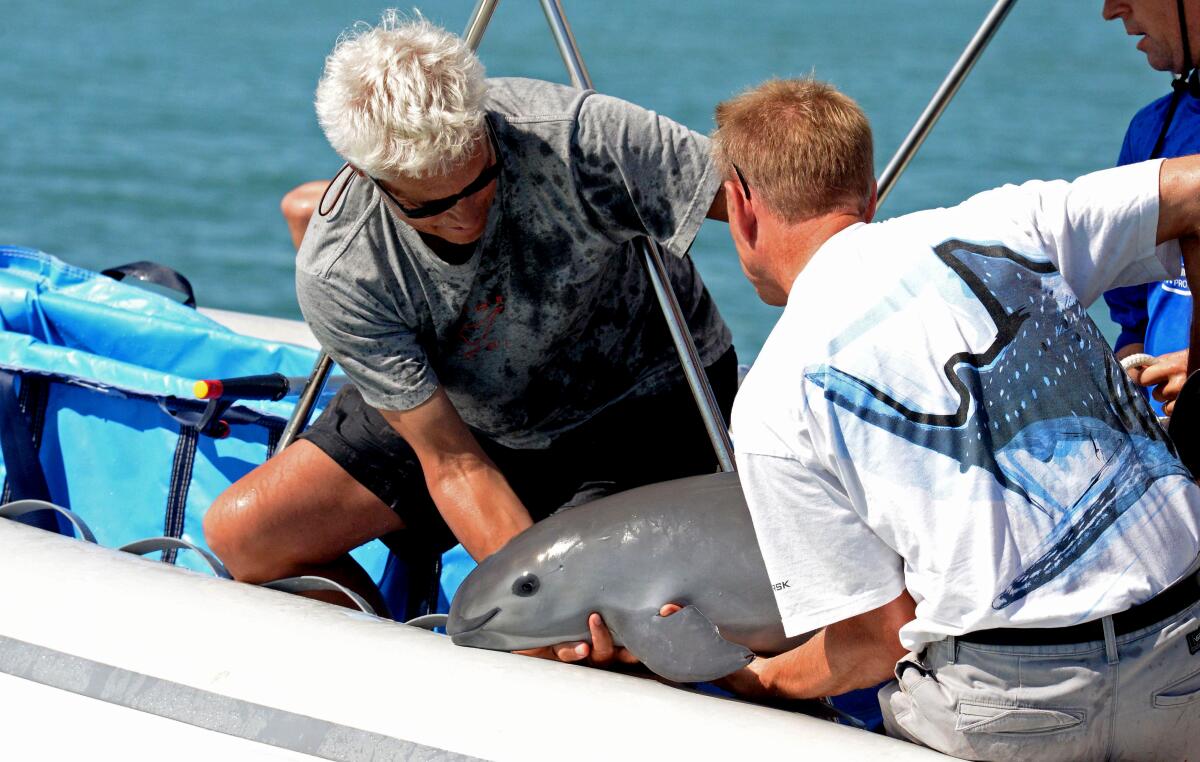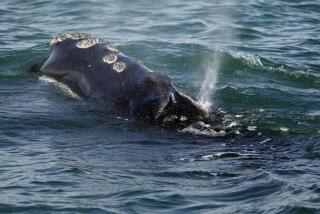Experts estimate only 8 endangered porpoises may remain off Mexico

- Share via
MEXICO CITY — Scientists estimate that only about eight of the world’s most critically endangered porpoises may remain in the Gulf of California, the only place where the vaquita marina lives, an environmental group said this week.
Pritam Singh, chairman of the Sea Shepherd group, said its crews had not seen any of the elusive porpoises during about three dozen trips this year to what is believed to be the last area in the gulf where vaquitas live.
But he said scientists from the International Union for Conservation of Nature reviewed images taken late last year that suggest eight adults and perhaps one or two calves are still in the gulf, also known as the Sea of Cortez.
Vaquitas drown in illegal nets set by fishermen to catch totoaba, a fish whose swim bladder is a delicacy in China and sells for thousands of dollars per pound.
The Mexican government has been criticized for partially giving up on efforts to enforce a zero-fishing zone in the last known area of the gulf where vaquitas live. But Singh said that while there were a lot of small fishing boats in the zero-fishing area early this year, coordination between Sea Shepherd and the Mexican navy has helped cut down on the vessels.
Singh said that the first three days Sea Shepherd patrolled the area this year, its crew sighted 58 fishing boats on the first day, 35 the second and 27 on the third. During its most recent trip, those numbers were down to between one and three boats per day, he said.
“That is great news,” Singh said. “That helps to give the vaquita a chance.”
Last year, the Mexican government abandoned the policy of maintaining a “zero tolerance” zone in the upper gulf. It then introduced a sliding scale of punishments if more than 60 fishing boats are seen in the area on multiple occasions.
For years, Mexico relied on Sea Shepherd boats to remove most of the illegal nets that trap and drown vaquitas, while doing relatively little to combat violent attacks by poachers on the environmentalists’ ships. The group estimates it removed about 1,000 of the long, heavy nets over the last six years.
But the environmentalists were forced to leave the gulf in January 2021 after a New Year’s Eve attack in which fishermen rammed a Sea Shepherd vessel with their boat. One of the fishermen later reportedly died of injuries sustained in that attack.
Since then, the job of locating and removing nets has been largely left to Mexico’s navy, acting on reports from Sea Shepherd vessels. Mexican authorities allowed the group to return to the gulf about a year after it was forced out, but it no longer allows the group to remove illegal nets.
In February, the U.S. Trade Representative’s Office filed the first trade-based environmental complaint against Mexico for failing to protect the vaquita marina, which is the world’s smallest porpoise.
The office said it had asked for “environment consultations” with Mexico, the first such case it has filed under the U.S.-Mexico-Canada free trade pact. Consultations are the first step in the dispute resolution process under the treaty, which took effect in 2020. If not resolved, it could eventually lead to trade sanctions.
Mexico’s Economy Department said after the complaint was announced Thursday that “the Mexican government reaffirms its commitment to the proper implementation of the USMCA and the responsibilities it has within it.”
President Andrés Manuel López Obrador has expressed his dislike of foreign interference, and his desire to balance the interests of fishermen and endangered species.
“We don’t need foreigners telling us what to do or placing sanctions on our country’s fishermen,” López Obrador said in 2021. He insisted that “we can reach an agreement that seeks an equilibrium between fishing and productive activities, and taking care of species.”
More to Read
Sign up for Essential California
The most important California stories and recommendations in your inbox every morning.
You may occasionally receive promotional content from the Los Angeles Times.










